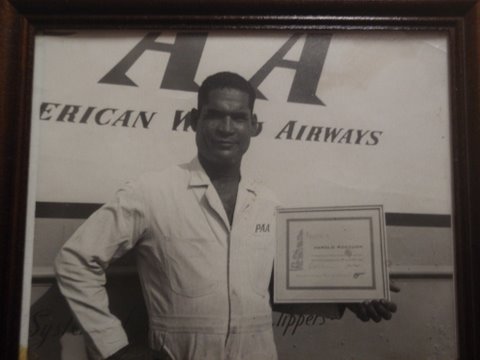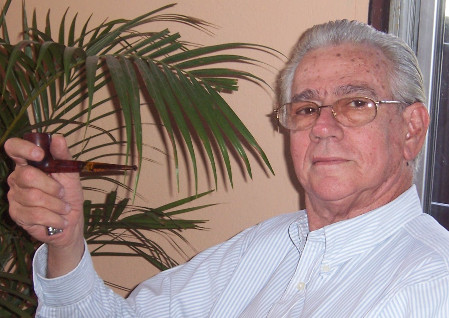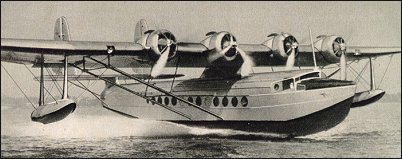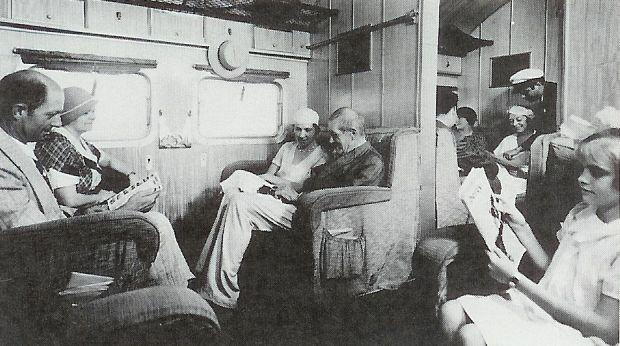
I'm using this directory to collect information about the crash of US NC 15376 (the Dominican Clipper", from the Ed Coates Civil Aircraft Photograph Collection>):

This was Pan American flight 203, October 3, 1941. This flight
started at Miami Florida at 07:33 EST and was destined for Buenos Aires, Argentina.
It never arrived. Instead it crashed on landing at it's stop in San Juan Harbor, Puerto
Rico. I am interested in this flight because my father was the flight mechanic on the
plane.
At left is what my father looked like in 1942 shortly after the accident (from a US Coast Guard ID photo).

 At right is what he looked in 1958
when I began to know him at age 10 - with my brother and mother in a Christmas photo.
At right is what he looked in 1958
when I began to know him at age 10 - with my brother and mother in a Christmas photo.
I notice from my father's log book (initially received as a gift from his uncle, Caspar (Cap, "Million Mile") Swinson) that he first flew NC15376 as co-pilot on May 26, 1936. He flew it and other S-42s and Consolidated Commodores many, many times between November of 1933 and at least October 1936 when the log book I have ends. Here his first log entry flying as co-pilot (second officer) on NC15376. There are many other samples from that log book along with other documents of the time in this directory: JDDonnelley.
As I collect information about the flight and crash I will post it here. Initially (March 2004) I obtained the Civil Aeronautics Board report on the accident and some pictures of the parts of the aircraft (a Sikorsky S-42 seaplane) apparently after they had been salvaged, examined, and were ready for scrap:
These came from the Richter Library at the University of Miami with the help of my cousin, John Hester. You can click on those images to get higher resolution scans - taken from 8 1/2 x 11 photo copies.
More recently (summer 2009), as a result of this Web page, I've gotten some additional information about NC15376. I was informed about these images for sale as their original 3x5 photographic prints on eBay:
The above photos are apparently from the salvage operation after this earlier accident from February 19, 1939 where the aircraft water looped on landing.. There you can see the aircraft initially being lifted from the water by the crane seen in the images (P.R. Lighterage Co. - confirmed company of the time). I was able to buy the second photographic print (front, early) and found that the resolution of the originals is about the same as the images posted for information on eBay (above). I rescanned the 3x5 photo that I bought, but the results weren't noticeably better than the above:
Of course one might wonder if this earlier accident did any damage to the aircraft that might have contributed to the later accident.
I found it interesting that in the 1941 accident the plane sank in only 15 feet of water.
The CAB report
refers to the heroic efforts by Mr. Harold Roebuck
(photo from his niece below right)
 Mary Roebuck, provided by his eldest grandson, Harold Roebuck, III), a native
Puerto Rican (actually it seems Harold Roebuck Sr. was born in St. Croix in 1907),
who "repeatedly dived and swam through the partially
submerged cabin, freeing passengers and removing them from the
wreckage. This action was attended by considerable hazard
and physical discomfort as the surface of the water was covered
by gasoline from the wreckage." (quote from the CAB report).
Mary Roebuck, provided by his eldest grandson, Harold Roebuck, III), a native
Puerto Rican (actually it seems Harold Roebuck Sr. was born in St. Croix in 1907),
who "repeatedly dived and swam through the partially
submerged cabin, freeing passengers and removing them from the
wreckage. This action was attended by considerable hazard
and physical discomfort as the surface of the water was covered
by gasoline from the wreckage." (quote from the CAB report).
The two youngest Russo girls, Suzie (14 months old) and Marie-Jo (24 months old), were killed in the accident. Mrs. Angelina Russo and her 3 year son Fred were in seat belts. Angelina was holding one of the younger girls and a steward was holding the other (according to the CAB report). The two young girls were thrown on impact and couldn't be found after that until their bodies were recovered. After the accident the CAB report indicates that Pan American set up a strap system to secure infants to those who are holding them during takeoffs and landings. That seems beyond what is done today.
One of the most exciting connections I've made with this page is
that with the surviving child, Dr. Fred Russo (age 71 below left).
 Fred had some direct memory and considerable family history about
the accident. This included (slightly edited and reorganized into time sequence from an email):
Fred had some direct memory and considerable family history about
the accident. This included (slightly edited and reorganized into time sequence from an email):
As the plane was landing Marijoe got up and came to look out the window with me. As the plane hit the water the window blew up in my face and the glass went into my right eye arcade and, as per my parents, my eye ball was out of its socket (sorry to be so gruesome but these are small details that will help to understand what went wrong). On impact Marie-jo was projected into the pilot's cabin which at the time was opened and should have been closed during landing (no mention of this issue in the CAB report).
I was in the water when someone carried me to my Mother Angelina who was bruised and hanging on the plane's wing in the sea. We were taken from the wing and placed in a Navy "Dingy" rubber boat. I remember I saw red, probably the blood running out of my eye, and I only had one white shoe and lost the other and of course cold and crying. Unfortunately the Navy due to security reason during the war send all ships out to sea at night and only had small boats for the rescue (according to the Boston newspaper article - below - the Coast Guard cutter Unalga "sped to the rescue").
The next morning my Father, with his Navy crew from the Naval Air Station, found Marie-jo in the pilot's cabin with severe head trauma and deceased. My younger sister Susie was found a few days latter floating in the bay of San Juan. Both were buried in Puerto Rico. A year latter when my Father was transferred and we were returning to Haiti "They" refused to give us back the bodies of the two girls. My Mother decided that she would not leave Puerto Rico unless "They" gave her back her two daughters. The Governor of Puerto Rico, then Mr. Munos Marin, and President Roosevelt did intervene and as per President's Roosevelt telegram "...Donnez pleine satisfaction a Madame Russo.." Then my 2 sisters were buried in Haiti in our family vault and now my Father Salvatore Russo Lt/USNRet (by the way his birthday is tomorrow February 3rd 2009. He would have been now 106 years old!) as well as my Mother have joined their daughters. Please note I am not sad any more telling this story. I have came to accept the facts of life as must we all.
By closing this note I want to remember all of the heros families who had contributed to the salvage of this plane crash and especially Mr. Roebuck and Mr. Keating. May the Good Lord save a priviledged place for them in Heaven as MEN down here did never recognize and reward and thank them for their unselfish heroic efforts. From one Gratefull survivor of this plane crash 68 years ago! May God bless and protect us all... We cannot escape our Destiny. Fred Russo
I think perhaps these pictures can help flesh out this story a bit. This
first is a picture of an S-42 during it's take off run (much like landing):

This second is of the interior of an S-40 - much like an S-42 - looking
up toward the compartment "D" area just behind the captain's cabin, at
the upper right in the picture:

That compartment "D" was the area where Fred Russo, his mother,
the steward, and Fred's two younger sisters where sitting at the
time of the crash. You can see what the windows looked like, getting
an idea for what it must have been like for young Fred to have one
smash into his face as the aircraft twisted to a halt in the water.
Here is a video clip that shows some S-40s and S-42s landing and berthed at the Pan American terminal at Dinner Key in Miami, Florida. It's an S-42 that is coming into land starting at 0:37 in that clip. In fact in that clip at 1:02 you can see the very Dominican Clipper, NC15376, that our father and the others were in when it crashed in San Juan, Puerto Rico.
In this New York Times article about the accident I was able to find a passenger list:
These boarded at Port au Prince:
These are the crew members:
Those were all the 27 people onboard the NC15376 at the time of the accident in San Juan harbor.
I find it interesting how much Pan American downplayed the injuries to the passengers during the crash. For example, I know that young Fred Russo had a serious head injury from the window that he was looking out shattering into his face. His eye was knocked out of it's socket. Fortunately his eye was saved (he later became a doctor), but he had some serious surgery and still bears the scars.
I've heard from relatives of two Boston area residents (the two Lawrences listed on the passenger list) on that flight when it crashed. From one of them I received a newspaper article scan confirming the presence of both of them on the flight:
Boston Globe (or Herald) article about the NC15376 crash
The above article mentions the Coast Guard Cutter Unalga that "sped to the rescue." I haven't yet followed up on any connections with that ship.
The article mentions both Mr. Lawrence T. Ritchie (29), a Boston wool company executive, and Mr. Lawrence Keating, a Franklin MA. engineer. Besides the above article I also received from one of Mr. Lawrence T. Ritchie's sons, Robert, this period photograph of his father who assisted Mr. Russo:
Here is some recounted oral history of these families of both of these Boston area men who have a connection with Mr. Russo:
I have this message from Karen Milliman:
I've neglected to yet inform her that the newspaper from Mr. Ritchie does indeed confirm that Lawrence Keating was on that flight.
In Mr. Ritchie's oral family history there is also a connection to Mr. Ruzzo. Mr. Ritchie writes:
I believe he was picked up by a fishing boat, responding to the event.
Also I remember an Award or certificate he had received from Pan Am.
Robert Ritchie later filled in some details from his families oral history (actually a quote from his older brother Larry) about his father's interaction with Fred Russo:
I've also heard from others connected with this accident, but none with such startling connections - at least partly confirmed by records from the time.
The CAB report concluded that the wreck was the fault of the pilot, Captain Charles A. Lorber. He was landing the plane with the nose too low and had turned off the engines too soon. This was compounded by a slight cross wind that was moving the plane to the left somewhat and the fact that he was landing downwind with a 3 Mph tail wind. Apparently sometimes the flight engineer is responsible for managing the engine speeds. The choice is up to the captain. In this case captain Lorber was managing the engine speeds himself - fortunately for our father (or perhaps not ?, he might have been able to prevent the accident by running the engines longer). Our father felt that captain Lorber was negligent (perhaps retaining too much of his old barn storming attitude?) and should have managed the landing safely by following standard procedures.
Here is a page from "Pan Am, An Airline and its Aircraft", by R.E.G Davis that describes Pan AM's S-42 fleet. This page incorrectly lists the date that NC 15376 was lost as March 10, 1941. This mistake was apparently due to a misinterpretation of the European method of writing dates, taking 3/10/41 as March 10, 1941 instead of October 3, 1941 as was intended.
Note: Some of these materials are subject to copyright restrictions from the Richter Library. The page from the R.E.G. Davis book are copyright by R.E.G. Davis and by Mike Machat. The eBay photos besides mine have unknown copyright. All these materials are placed here for the private use of myself and those who I am working with using these materials.